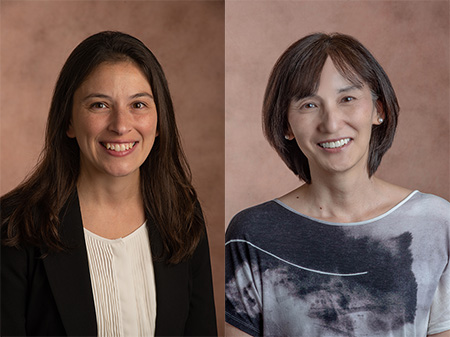
For close to two years now, a collaboration by two WMed researchers has sought to fill a longtime knowledge gap in B-cell biology by closely examining the developmental process of all B-cell subsets, from fetus to adult, and exploring their precise origins and functions.
Now, that work by Nichol Holodick, PhD, and Momoko Yoshimoto, MD, PhD, is being helped by a five-year, $2.97 million grant from the National Institutes of Health that was awarded to WMed in December. The R01 grant is the largest research award the medical school has ever received from the NIH.
The funding will support the research project “The developmental pathway of fetal-derived B cells,” which Drs. Holodick and Yoshimoto are leading as co-principal investigators. The project is a merging of their talents and past research.
Dr. Yoshimoto’s research path is motivated by her prior clinical experience as a pediatric hematology/oncologist in Japan and her ongoing study of the development of hematopoietic stem cells and their specifications to individual blood cell linages in the mouse embryo. Meanwhile, Dr. Holodick has spent more than a decade researching and examining B cells to understand more about their immune response in the human body.
“We are interested in the different angles of B cell development,” Dr. Yoshimoto said recently. “It’s been fun to learn from each other.”
For Drs. Holodick and Yoshimoto, who both serve as researchers in the medical school’s Center for Immunobiology and associate professors in the Department of Investigative Medicine, the NIH-funded research project will offer the opportunity to challenge the basis of stem cell theory and a central concept of hematology and oncology that all blood cells are derived from hematopoietic stem cells (HSCs). Bone marrow transplant therapy for blood disorders draws from the concept that donor HSCs can replace all blood cells of a recipient.
However, according to Dr. Yoshimoto, recent research has challenged that theory and shown that some immune cells develop from endothelial cells (EC) of the embryo in an HSC-independent manner and these immune cells may not be replaced by HSCs.
“Furthermore, it has been reported that a significant percentage of conventional B cells (B-2 cells) also originate from fetal EC progenitors in the embryo and persist into old mice,” Drs. Holodick and Yoshimoto said in their research project abstract. “These striking results highlight a huge knowledge gap in the hematology and immunology fields because HSC-independent B-2 cell development has yet to be recognized. Since B cells play important roles in protecting against infections and in the pathology of autoimmune and other diseases, it is critically important to understand the developmental pathways of HSC-independent B-cells and their functions compared to HSC-derived counterparts.”
Dr. Holodick said the collaboration between her and Dr. Yoshimoto began to take shape in 2022 at the Annual Meeting of the American Association of Immunologists (AAI). It was at that meeting, Dr. Holodick said, that she first became aware of Dr. Yoshimoto’s research and the work she had done with the lineage tracing of embryo to adult B-cell subsets.
“We really want to understand how the fetal-born B cells in the mice persist into old age, how they function throughout life, and how they change in immunological ways,” Dr. Holodick said. “Do they still produce the same number of antibodies and do functions differ or disappear?
“In 2022, I was very excited to see Dr. Yoshimoto’s elegant way of labeling different B cells, but from different progenitors,” Dr. Holodick added. “If in her work she’s shown that 80 to 90 percent of those B cells are coming from fetal progenitors and different progenitors than anyone knew before, if you’re performing transplant surgeries with adult stem cells, it’s possible you may be missing out on those evolutionary conserved B cells.”
Drs. Yoshimoto and Holodick said their preliminary research has shown that there are at least three types of B cell development – innate immune B-1 cell development; common progenitors for innate B-1 and conventional B-2 cells, and B-2 dominant progenitors derived from HSCs.
As their research project continues, Drs. Yoshimoto and Holodick said they aim to determine the functional differences of B cells based on their origins and put together a revised B-cell development map, from embryo to adult, using combinations of various lineage tracing and in vivo barcoding mouse models.
“We have to explore if this can be translated to humans and think about how we might alter certain therapies and how we can protect older adults from new infection,” Dr. Yoshimoto said. “The idea is to potentially reshape the idea of hematology and oncology.”
